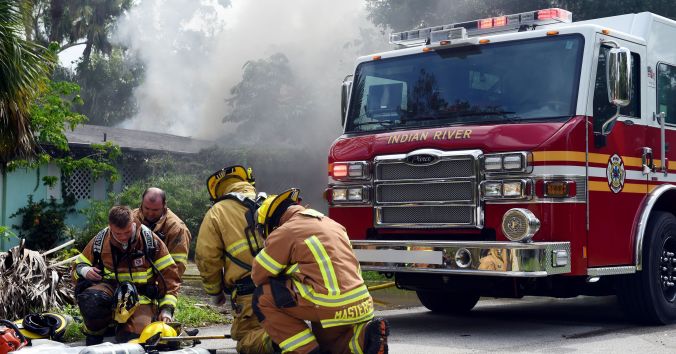
The Indian River County Emergency Services Department (IRCES) may need help with the retention of firefighters and first responders.
We learned from an Indian River County (IRC) Public Records Request that there were 68 firefighters/first responders who resigned from the workforce in the past three years.
Resigned in 2015 – 20
Resigned in 2016 – 27
Resigned in 2017 – 21 (as of September)
Using an average of 23 resignations per year, with 282 reported firefighters (as of October 30) who serve in 15 IRC fire stations (this number fluctuates due to turnover), annual turnover is roughly 8%.
However, on October 23 we learned from a reliable source that IRCES lost eight firefighters in the last three weeks. Does 21 resignations as of September mean 29 as of October? That would be 10% turnover.
We have been unable to find any data on retention rates on emergency services departments in other counties/municipalities in Florida or other states to see how this percentage compares.
What is the cost of these turnovers from the IRCES recruiting process; as well as administrative overhead?
But, then there is training for the newly hired firefighters/first responders.
Unfortunately, Emergency Services did not have any documents responsive to our request on how many firefighter/first responders are under the age of 21, the average level of experience and the cost to train a new hire.
(We were curious if there were any firefighters who, under the drinking age, are responding to emergencies.)
In terms of training we were able to find this data:
According to the National Volunteer Fire Council, “The cost to train and equip a firefighter can exceed $20,000. Below are average expenses associated with firefighting. Please note product costs vary depending on a variety of factors, and these are just estimates. Certain pieces of equipment, such as radio and thermal imager, may not be provided to every firefighter. Training costs vary considerably from state to state and jurisdiction to jurisdiction, depending on what level and types of training are required.”
| Helmet | $ 300 | Gloves | $ 95 |
| Coat | $ 1,200 | SCBA | $ 6,300 |
| Pants | $ 875 | Radio | $ 3,700 |
| Boots | $ 300 | Thermal Imager | $ 1,200
|
| Hood | $ 40 | Training | $ 7,800 |
Bearing in mind that some of the equipment costs referred to above are non-renewable costs (helmets, gloves, coats, pants, boots, radios, etc.), which get turned over to the next new hire, let’s say the number is $ 15,000
Using $ 15,000, if 30 people were to resign in a year, 30 X $ 15,000 = $ 450,000
How many firefighters/first responders live in Indian River County?
Other data gathered with our Public Records Request is that only 149 of the 282 firefighters/first responders live in IRC. That means 133 firefighters/first responders and their families live outside IRC, in another county. Roughly 47%.
These 133 people come to Indian River County for their shifts and go home to Port St. Lucie, Ft. Pierce, Fort Lauderdale, Wellington, Lauderhill or West Palm, for example.
Data indicated most of them live south of Indian River County.
There they buy groceries and other goods and services for themselves and their families. What is the cost of that loss of commerce?
Starting pay is roughly $ 42,000 for a firefighter paramedic in IRC.
If $ 42,000 is starting pay, less $ 4,166 in Federal taxes (taxcollector.com), then $ 37,834 is spent outside Indian River County.
133 firefighters/first responders who live outside Indian River County x $ 37,834 spent outside IRC = $ 5,031,922 in lost commerce.
IRCES does not appear to have any recruitment program, such as the IRC Sheriff’s Department, to attract and develop people from within Indian River County.
Then there is the compensation.
We found a job opening for a Firefighter Paramedic in Lauderhill posted on indeed.com on October 23, 2017 with a starting salary of $ 57,067 (Lauderhill-fl.gov). Roughly $15,000 more than IRC.
Question: Could there be a pattern?
Given the turnover, could there be a pattern that some of the 133 firefighters/first responders who live outside Indian River County came here for a job, to get trained, and then plan to leapfrog back to West Palm or where ever to be closer to home?
Here’s is some data on with what pay is being offered elsewhere.
According to the Martin County Board of County Commissioners Classification and Compensation Manual, revised June, 2017 the starting pay for a Firefighter EMT is $ 43,118 (Step one of 12) and a $ 49,915 for a Firefighter Paramedic (Step one of 12).
The City of Fort Lauderdale Pay Plan as of October 8, 2017 has the starting salary for a “firefighter” is $ 49,212 (Class 635; fortlauderdale.gov).
The city of Gulfport is advertising for a Firefighter/Paramedic with a salary of $ 47,911.50
But then, to be fair, there is an indeed.com posting for a Firefighter/EMT or Firefighter/Paramedic in Melbourne with a starting salary of $ 38,054.
We suspect that many of the counties south of Indian River County have better pay and benefits, which is where most who do not live in Indian River County come from.
Also, it seems evident it is more expensive to hire a Firefighter/Paramedic than a Firefighter/EMT.
We are just raising the question. Does the Indian River County Emergency Services Department need to address retention?

It appears to me that this is one of the areas of discussion where the interests of the City and the interest of the county intersect. This is one of the reasons that land use policy and issues of growth and planning as well as property taxation are more than solely a City council issue.
That point aside, in my work on urban studies it is common that Cost of Living is a major concern for anyone working in public services. The situation of professional turn-over is common where there are high costs for housing. A jurisdiction can not have it both ways. A city or county can not have a label for being an exclusive or “posh” area and at the same time be an area where all people feel welcome and able to work and live in comfort and be respected for their talents and contribution to the community.
LikeLike
I know 2 firefighters who work/worked in St. Lucie County – one retired about a year ago and the other will retire in 18 months. Do your numbers reflect retirements vs quit or were let go?
Unless you know for a fact that this is a number greater than most other similar counties in similar markets, this article serves as interesting information on the cost of employing firefighters and nothing more.
LikeLike
Susan, if irrelevant, then so why was the click data on this article at over 2,500 since published. One of the top accessed post in three years. It hasn’t even, yet, been sent to our distribution list.
LikeLike
Our numbers do not include terminations or retirements.
LikeLike
Another IMPORTANT issue is that being minimally staffed, when a vacancy occurs it is usually covered by overtime. Hence IRC when they hire a replacement FF. They are paying that firefighter as he/she goes through training and in addition paying someone 1 1/2 time to cover the trainee until he/she is released to work
LikeLike
Yes, 60 percent of the department has two years or less of service. Big turnover rates with the department.
LikeLike
Pingback: Yes, Sir, We Will Research the Situation with Any Underfunding of Pension Obligations in Vero Beach and Indian River County, FL. And How Those Pension Plans Work. | Vero Communiqué